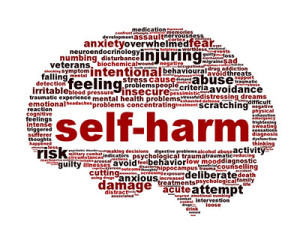 Self-harming behavior is sometimes referred to “self-mutilation” or “self-injury”. People who engage in self-harming behavior purposely hurt themselves to varying degrees depending on how serious the self-harming has become. Self-harming behavior takes many forms. Self-harming usually begins in adolescence or the early 20s. In the majority of cases, the act of self-harm is not for the purpose of suicide although the risk of suicide in people who self-harm is higher than it is in the general public.
Self-harming behavior is sometimes referred to “self-mutilation” or “self-injury”. People who engage in self-harming behavior purposely hurt themselves to varying degrees depending on how serious the self-harming has become. Self-harming behavior takes many forms. Self-harming usually begins in adolescence or the early 20s. In the majority of cases, the act of self-harm is not for the purpose of suicide although the risk of suicide in people who self-harm is higher than it is in the general public.
Forms of Self-Harm
Self-harming behavior includes a wide range of activities (some of which are not considered by many people to be self-harm and are marginally acceptable in society). Examples include but are not limited to:
- Superficial or deep skin cutting is the most common self-harming behavior
- Burning, stabbing
- Hitting, head-banging, biting, eye poking
- Scratching, hair pulling
- Interfering with wound healing
- Self-poisoning
- Embedding objects
- Excessive tattooing, piercing or cosmetic surgery
- “Decorative” skin scarring
- Amputation of body parts including (but not limited to) castration and eye removal
Why do people self-harm?
Self-harming behavior is very complex and involves a number of components that vary from person to person. In general, self-harming appears to be a coping mechanism. Self-harmers know that what they are doing is not acceptable and they are very good at hiding the behavior and wounds. Most self-harmers do not wish attention. But for some, such as those with mental retardation, self-harm is used an attention-seeking or manipulative behavior. All of the following components which underlie self-harming do not necessary apply to every self-harmer:
- Finding relief from intense emotions like anxiety, depression, overwhelm, self-hatred, low self-esteem and perfectionism.
- Counteracting a lack of feelings as the physical and emotional pain a person feels from self-harm is the only time some people feel anything at all.
- Disassociating or depersonalizing from reality.
- Responding to the compulsion to self-harm when the behavior has become a psychological addiction. Addiction can develop in chronic self-harmers.
- Seeking pleasure if the act makes the person feel good.
Self-harming behavior is also associated with a number of clinical conditions and abnormal environments. Though not as common, it is sometimes found in people who do not have any other clinical condition and appear to have normal, successful lives. Some conditions and environments that are associated with self-harming are:
- Anxiety disorders & phobias
- Autism
- Bipolar disorder
- Borderline personality disorder
- Conduct disorders
- Depression
- Eating disorders such as Binge Eating Disorder or Bulimia
- Incarceration (especially prevalent)
- Mental retardation
- Past or current physical, sexual and emotional abuse
- Post traumatic stress disorder
- Psychosis (acute or chronic)
- Substance abuse, especially that involving sedatives or alcohol
- War, poverty, unemployment, bereavement
Treatment and Prognosis for Self-Harming
There are treatments for self-harming behavior. Not all people who engage in self-harm require all of the treatments available. Each self-harmer needs specialized attention that targets the specific components of the self-harmer’s disorder. Available treatments for self-harming behavior include:
- Engaging in biofeedback training
- Incorporating a Self-Injurious Behavior Inhibiting System (SIBIS)
- Learning avoidance and distraction techniques
- Living in a long-term psychiatric hospital
- Removing self-harming objects from environment
- Removal of the person from an abusive or trauma-inducing environment
- Substituting safer methods of self-harm such as rubber-band snapping on the wrist
- Taking medication for schizophrenia when the condition is present
- Taking mood stabilizing, depression and/or anxiety medications
- Undergoing Cognitive and/or Dialectical Behavioral Therapy
Treatment for self-harming behavior is a long-term process. Success has been found in self-harmers who desire to end the self-harming, are highly motivated and are persistent with the necessary treatments.

